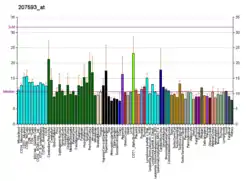| ABCG4 | |||||||||||||||||||||||||||||||||||||||||||||||||||
|---|---|---|---|---|---|---|---|---|---|---|---|---|---|---|---|---|---|---|---|---|---|---|---|---|---|---|---|---|---|---|---|---|---|---|---|---|---|---|---|---|---|---|---|---|---|---|---|---|---|---|---|
| Identifiers | |||||||||||||||||||||||||||||||||||||||||||||||||||
| Aliases | ABCG4, WHITE2, ATP binding cassette subfamily G member 4 | ||||||||||||||||||||||||||||||||||||||||||||||||||
| External IDs | OMIM: 607784 MGI: 1890594 HomoloGene: 75179 GeneCards: ABCG4 | ||||||||||||||||||||||||||||||||||||||||||||||||||
| |||||||||||||||||||||||||||||||||||||||||||||||||||
| |||||||||||||||||||||||||||||||||||||||||||||||||||
| |||||||||||||||||||||||||||||||||||||||||||||||||||
| |||||||||||||||||||||||||||||||||||||||||||||||||||
| |||||||||||||||||||||||||||||||||||||||||||||||||||
| Wikidata | |||||||||||||||||||||||||||||||||||||||||||||||||||
| |||||||||||||||||||||||||||||||||||||||||||||||||||
ATP-binding cassette sub-family G member 4 is a protein that in humans is encoded by the ABCG4 gene.[5][6]
The protein encoded by this gene is included in the ATP-binding cassette transporter (ABC protein) superfamily. ABC proteins transport various molecules across extra- and intra-cellular membranes. ABC genes are divided into seven distinct subfamilies (ABC1, MDR/TAP, MRP, ALD, OABP, GCN20, White). This protein is a member of the White subfamily and is expressed predominantly in liver tissue. The function has not yet been determined but may involve cholesterol transport. Alternate splice variants have been described but their full length sequences have not been determined.[6]
ABCG4 has demonstrated, in vitro, to participate in the efflux of desmosterol and amyloid-β peptide (Aβ). It is highly expressed in the brain, but its localization and function at the blood-brain barrier (BBB) level remain unknown.[7]
See also
References
- 1 2 3 GRCh38: Ensembl release 89: ENSG00000172350 - Ensembl, May 2017
- 1 2 3 GRCm38: Ensembl release 89: ENSMUSG00000032131 - Ensembl, May 2017
- ↑ "Human PubMed Reference:". National Center for Biotechnology Information, U.S. National Library of Medicine.
- ↑ "Mouse PubMed Reference:". National Center for Biotechnology Information, U.S. National Library of Medicine.
- ↑ Dean M, Rzhetsky A, Allikmets R (Jul 2001). "The human ATP-binding cassette (ABC) transporter superfamily". Genome Res. 11 (7): 1156–66. doi:10.1101/gr.184901. PMID 11435397. S2CID 9528197.
- 1 2 "Entrez Gene: ABCG4 ATP-binding cassette, sub-family G (WHITE), member 4".
- ↑ Dodacki, Agnès (2017). "Expression and function of Abcg4 in the mouse blood-brain barrier: role in restricting the brain entry of amyloid-β peptide". Scientific Reports. Springer Nature. 7 (1): 13393. Bibcode:2017NatSR...713393D. doi:10.1038/s41598-017-13750-0. PMC 5645361. PMID 29042617.
Further reading
- Engel T, Lorkowski S, Lueken A, et al. (2001). "The human ABCG4 gene is regulated by oxysterols and retinoids in monocyte-derived macrophages". Biochem. Biophys. Res. Commun. 288 (2): 483–8. doi:10.1006/bbrc.2001.5756. PMID 11606068.
- Annilo T, Tammur J, Hutchinson A, et al. (2002). "Human and mouse orthologs of a new ATP-binding cassette gene, ABCG4". Cytogenet. Cell Genet. 94 (3–4): 196–201. doi:10.1159/000048816. PMID 11856881. S2CID 19897612.
- Yoshikawa M, Yabuuchi H, Kuroiwa A, et al. (2002). "Molecular and cytogenetic characterization of the mouse ATP-binding cassette transporter Abcg4". Gene. 293 (1–2): 67–75. doi:10.1016/S0378-1119(02)00719-9. PMID 12137944.
- Oldfield S, Lowry C, Ruddick J, Lightman S (2002). "ABCG4: a novel human white family ABC-transporter expressed in the brain and eye". Biochim. Biophys. Acta. 1591 (1–3): 175–9. doi:10.1016/S0167-4889(02)00269-0. PMID 12183068.
- Strausberg RL, Feingold EA, Grouse LH, et al. (2003). "Generation and initial analysis of more than 15,000 full-length human and mouse cDNA sequences". Proc. Natl. Acad. Sci. U.S.A. 99 (26): 16899–903. Bibcode:2002PNAS...9916899M. doi:10.1073/pnas.242603899. PMC 139241. PMID 12477932.
- Cserepes J, Szentpétery Z, Seres L, et al. (2004). "Functional expression and characterization of the human ABCG1 and ABCG4 proteins: indications for heterodimerization". Biochem. Biophys. Res. Commun. 320 (3): 860–7. doi:10.1016/j.bbrc.2004.06.037. PMID 15240127.
- Gerhard DS, Wagner L, Feingold EA, et al. (2004). "The status, quality, and expansion of the NIH full-length cDNA project: the Mammalian Gene Collection (MGC)". Genome Res. 14 (10B): 2121–7. doi:10.1101/gr.2596504. PMC 528928. PMID 15489334.
- Engel T, Bode G, Lueken A, et al. (2006). "Expression and functional characterization of ABCG1 splice variant ABCG1(666)". FEBS Lett. 580 (18): 4551–9. doi:10.1016/j.febslet.2006.07.006. PMID 16870176. S2CID 22947257.
- Vaughan AM, Oram JF (2007). "ABCA1 and ABCG1 or ABCG4 act sequentially to remove cellular cholesterol and generate cholesterol-rich HDL". J. Lipid Res. 47 (11): 2433–43. doi:10.1194/jlr.M600218-JLR200. PMID 16902247. S2CID 15872767.
External links
- ABCG4+protein,+human at the U.S. National Library of Medicine Medical Subject Headings (MeSH)
- Human ABCG4 genome location and ABCG4 gene details page in the UCSC Genome Browser.
This article incorporates text from the United States National Library of Medicine, which is in the public domain.




